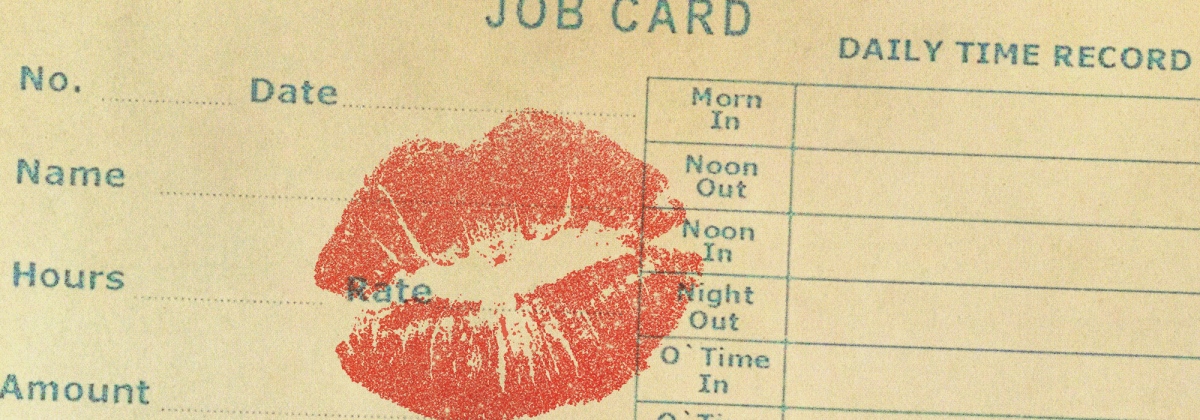For most people that do most kinds of jobs, inspiration probably looks a lot like money. Less commonly, perhaps one of the things unique to creative professions, is for inspiration to come from other people’s work. But also, like, money too…
I’m interested in the way that the work can be such a turn-on. Visual experiences have always fascinated me…since I was a kid. It took me years to find a direction to point that energy and interest, but eventually, I became a designer.
It’s also worth noting here that I think any profession can be inspired, and therefore creative. It’s perhaps an attitude more so than a style or type of job.
Below, I have designer Kurt Volk, curator Angelina Lippert, and chef Mike Dimmer, each explaining what sparked them to pursue what it is they do…
Kurt Volk,
Designer, Troublemaker Studios and El Rey Network
Kurt has headed design projects for director Robert Rodriguez’s Troublemaker Studios since 2003. He’s created posters and key art, graphic elements that appear in films, title sequences, books, digital and printed promotional pieces, and likely hundreds and hundreds and hundreds of other things that many of us don’t even realize.
Kurt has supervised my work for El Rey Network (a production of Troublemaker) since I began working with them early in 2017. In my experience, Kurt always seems up for a challenge, and likely gets just that while spending his days at Troublemaker…
Who, or what, was one of your first inspirations for what you do and why?
“So when I was growing up, my grandfather owned a clip art business based on the east coast called Volk Art. It was more or less a stock illustration business — he would hire illustrators, designers and typographers to create original artwork that he would print into these small booklets and sell. He hired the great Herb Lubalin to design his logo and he worked with many of the great commercial illustrators of the era. Commercial art was sort of the family business ever since I can remember, so pursuing an art career was this very normal thing to do. There was never a debate about whether I’d become an artist, but what kind of artist I’d become.
My grandfather (I called him Pop Pop) would talk to me about Saul Bass and Milton Glaser when I was way too young to understand why, but his words taught me that there is a set of human hands behind everything I experience in culture. I remember looking at my Raiders of the Lost Ark trading cards and wondering who wrote the blurbs on the back, or wondering why the photo in People magazine from E.T. was from an angle that wasn’t in the movie itself. My grandfather was the first person to teach me to read the credits and to be curious about how creative things are made. He was the catalyst that launched me into making creative decisions of my own.”
Angelina Lippert,
Curator, Poster House
Angelina is the curator at Poster House in New York City. Poster House, which will open in 2019, is the first New York museum which will be dedicated exclusively to the art and medium of posters.
Working with board president Val Crosswhite, and director Julia Knight, Angelina is working to build Poster House in to a home which maps and explores human and graphic history and communication simultaneously. I’m so excited to see what they’re building.
Art history and conservation seems well established in Angelina’s career, but I was interested to find out how it got that way…
Who, or what, was one of your first inspirations for what you do any why?
“My interest in posters actually came about as a happy accident. I needed an internship the summer before heading to graduate school, and in this city you basically need to know someone in order to get a great internship. A childhood friend of mine said his father could get me a spot with his poster dealer, which was decidedly not what I wanted to do – at the time, I viewed posters the way a lot of people view them, as reproductions. And if I had $5,000 I thought (at the time) that I’d rather buy a painting, a unique work, than a printed multiple. But, I took the internship and, thanks to a really wonderful manager, got a lot more hands on experience than I’d ever get at a contemporary gallery or auction house. With her guidance, I started to see posters as not just decorative works of art, but also as little glimpses into history. Everything from big political movements to mundane products appear in posters, so you really get a more complete view of how people from a certain time and place lived – and I find that fascinating.
I ended up going back to the same gallery after grad school, and only left when I heard that they were starting a poster museum called Poster House in NYC. If you asked me in college if I thought I’d be the Chief Curator of a poster museum one day, I don’t think that would have ever occurred to me as a possibility – I thought I’d be running Sotheby’s Modern Art department! And, honestly, I’m glad the whole Sotheby’s thing didn’t pan out because dealing in such a specialized, small world invites so many more discoveries (and challenges) than your standard art world job.”
Mike Dimmer,
Chef, Marble + Rye
Mike Dimmer runs the kitchen at Marble + Rye in my hometown of Buffalo, NY. Marble + Rye is the best restaurant in Buffalo. Yep, I say that with bias, he’s been a friend of mine since before he was cooking, but it’s also a wholehearted belief. His food is great.
Mike created Marble + Rye with his business partner Christian Wilmott, who runs the dining room and bar. Buffalo has pretty specific, home-spun tastes. While pleasing that traditional appetite, Mike has added all kinds of interesting new ideas and built on top of the established food culture of Western New York.
What, specifically, moved him towards a restaurant of his own is a conversation I’ve never had with him. So, let’s see…
Who, or what, was one of your first inspirations for what you do any why?
“Working in the restaurant industry, it’s relatively easy for me to think of a dozen people and places that inspired me to open up my own restaurant and bar. As I now think about the actual reason I decided to go into this industry, I think the answer is sort of two-fold. First, I’ve worked in a lot of different areas in the hospitality industry. Most times, I would find myself saying “I could do this better”, but never wanted to have an attitude and arrogance towards someone else’s business, so I’d just put my head down and do things their way.
The real moment that I decided this is what I wanted to do with my life was when I was fired from a restaurant management position. As I left, I wasn’t angry or despondent. I felt relieved in the idea that I had learned so much. But what I learned is something that has carried through with me until this day. It wasn’t the recipes, techniques, front of house operation ideas that I was taking with me. I learned how NOT to run a business. I learned how NOT to treat employees. I learned how NOT to run your books and ‘pay’ your taxes. As I moved on from this place and into the next, that’s what I focused on. I never wanted to copy someone else’s style of business or food, but I wanted to make sure I learned from their mistakes. This was invaluable to me. To be able to see these mistakes with no real consequence to myself, and learn from them, was huge. I feel the restaurant industry is one of the few in this world that you can do that. There’s a million right choices to be made every day, but it’s that one wrong decision that can cripple and end you.
So, in all, the experience of being fired from a job I was really good at was the reason I stayed in this industry. Learning what not to do has become a big part of my life and my rental approach to business practices. And I have being rudely fired by an asshole to thank for that.”
Whether it’s the way a job is done, or the way it isn’t, it seems almost refreshing to find footprints already in the paths each of us are on. It’s not so terrifying, and it seems there’s good company along the way.
You can view Kurt’s work at kurtvolk.com.
More info on Poster House from Angelina at posterhouse.org.
More info on Mike and Marble + Rye is at marbleandrye.net.
Header image by me, Derek Gabryszak.
Thanks for reading Question Market 9!
Derek









